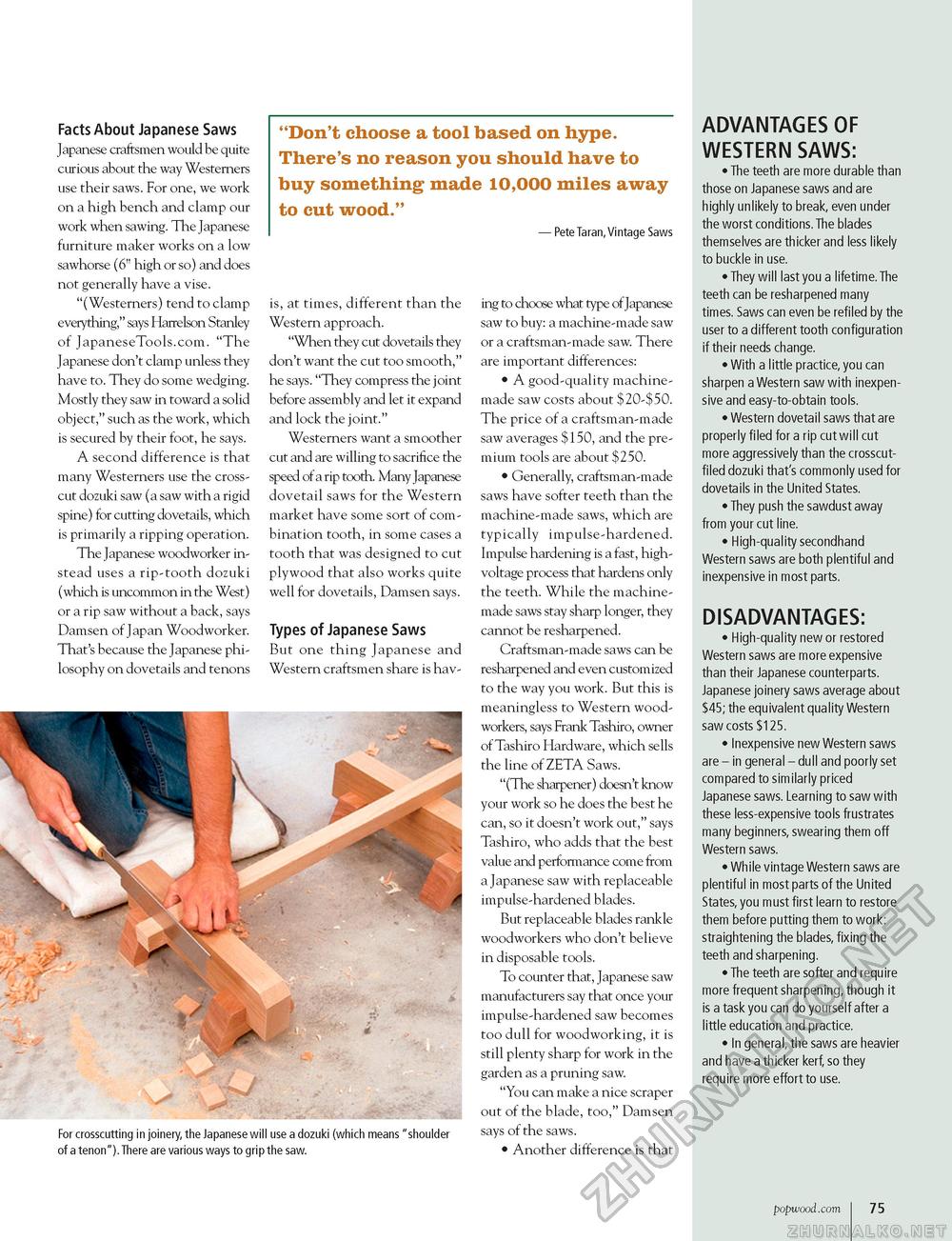Popular Woodworking 2003-10 № 136, страница 75
Facts About Japanese Saws Japanese craftsmen would be quite curious about the way Westerners use their saws. For one, we work on a high bench and clamp our work when sawing. The Japanese furniture maker works on a low sawhorse (6" high or so) and does not generally have a vise. "(Westerners) tend to clamp everything," says Harrelson Stanley of JapaneseTools.com. "The Japanese don't clamp unless they have to. They do some wedging. Mostly they saw in toward a solid object," such as the work, which is secured by their foot, he says. A second difference is that many Westerners use the crosscut dozuki saw (a saw with a rigid spine) for cutting dovetails, which is primarily a ripping operation. The Japanese woodworker instead uses a rip-tooth dozuki (which is uncommon in the West) or a rip saw without a back, says Damsen of Japan Woodworker. That's because the Japanese philosophy on dovetails and tenons "Don't choose a tool based on hype. There's no reason you should have to buy something made 10,000 miles away to cut wood." — Pete Taran,Vintage Saws is, at times, different than the Western approach. "When they cut dovetails they don't want the cut too smooth," he says. "They compress the joint before assembly and let it expand and lock the joint." Westerners want a smoother cut and are willing to sacrifice the speed of a rip tooth. Many Japanese dovetail saws for the Western market have some sort of combination tooth, in some cases a tooth that was designed to cut plywood that also works quite well for dovetails, Damsen says. Types of Japanese Saws But one thing Japanese and Western craftsmen share is hav- For crosscutting in joinery, the Japanese will use a dozuki (which means "shoulder of a tenon").There are various ways to grip the saw. ing to choose what type of Japanese saw to buy: a machine-made saw or a craftsman-made saw. There are important differences: • A good-quality machine-made saw costs about $20-$50. The price of a craftsman-made saw averages $150, and the premium tools are about $250. • Generally, craftsman-made saws have softer teeth than the machine-made saws, which are typically impulse-hardened. Impulse hardening is a fast, high-voltage process that hardens only the teeth. While the machine-made saws stay sharp longer, they cannot be resharpened. Craftsman-made saws can be resharpened and even customized to the way you work. But this is meaningless to Western woodworkers, says Frank Tashiro, owner of Tashiro Hardware, which sells the line of ZETA Saws. "(The sharpener) doesn't know your work so he does the best he can, so it doesn't work out," says Tashiro, who adds that the best value and performance come from a Japanese saw with replaceable impulse-hardened blades. But replaceable blades rankle woodworkers who don't believe in disposable tools. To counter that, Japanese saw manufacturers say that once your impulse-hardened saw becomes too dull for woodworking, it is still plenty sharp for work in the garden as a pruning saw. "You can make a nice scraper out of the blade, too," Damsen says of the saws. • Another difference is that ADVANTAGES OF WESTERN SAWS: • The teeth are more durable than those on Japanese saws and are highly unlikely to break, even under the worst conditions. The blades themselves are thicker and less likely to buckle in use. • They will last you a lifetime. The teeth can be resharpened many times. Saws can even be refiled by the user to a different tooth configuration if their needs change. • With a little practice, you can sharpen a Western saw with inexpensive and easy-to-obtain tools. • Western dovetail saws that are properly filed for a rip cut will cut more aggressively than the crosscut-filed dozuki that's commonly used for dovetails in the United States. • They push the sawdust away from your cut line. • High-quality secondhand Western saws are both plentiful and inexpensive in most parts. DISADVANTAGES: • High-quality new or restored Western saws are more expensive than their Japanese counterparts. Japanese joinery saws average about $45; the equivalent quality Western saw costs $125. • Inexpensive new Western saws are - in general - dull and poorly set compared to similarly priced Japanese saws. Learning to saw with these less-expensive tools frustrates many beginners, swearing them off Western saws. • While vintage Western saws are plentiful in most parts of the United States, you must first learn to restore them before putting them to work: straightening the blades, fixing the teeth and sharpening. • The teeth are softer and require more frequent sharpening, though it is a task you can do yourself after a little education and practice. • In general, the saws are heavier and have a thicker kerf, so they require more effort to use. popwood.com 75 |








